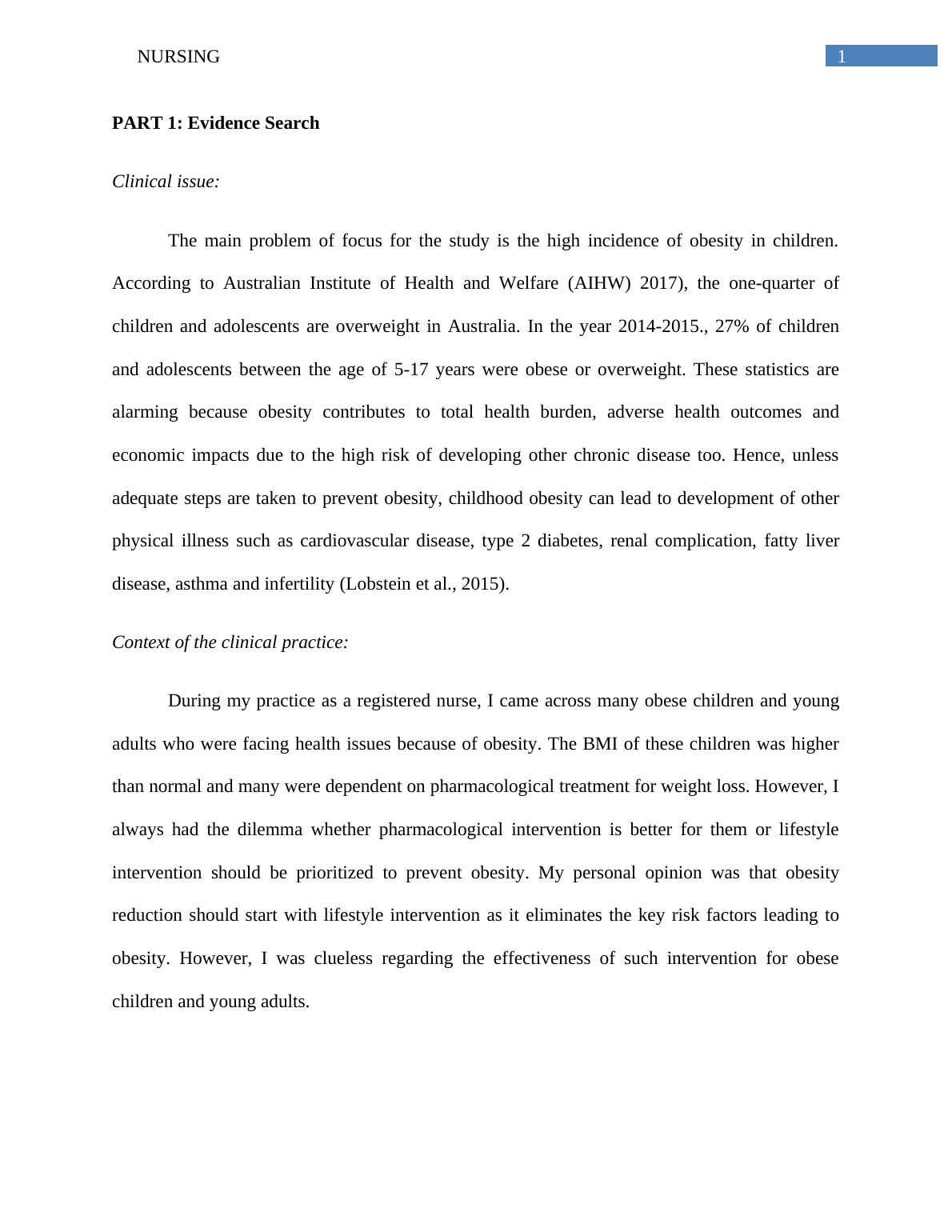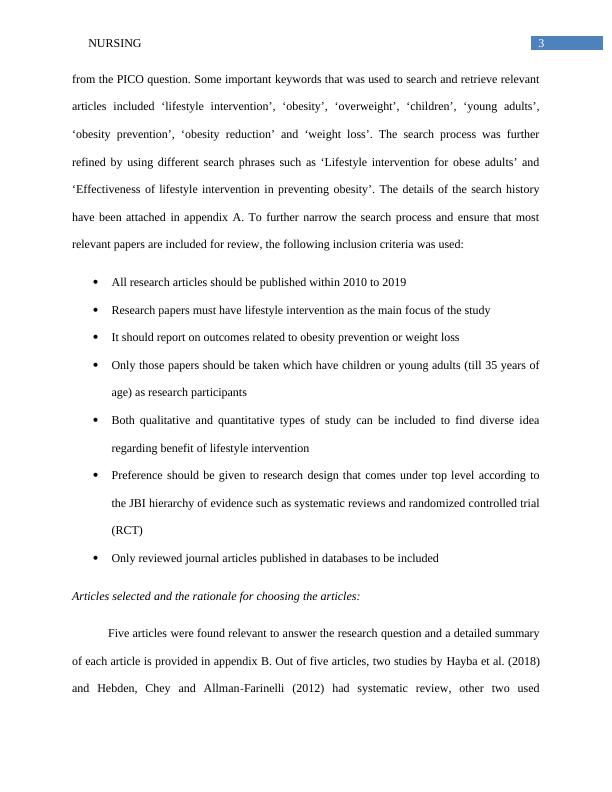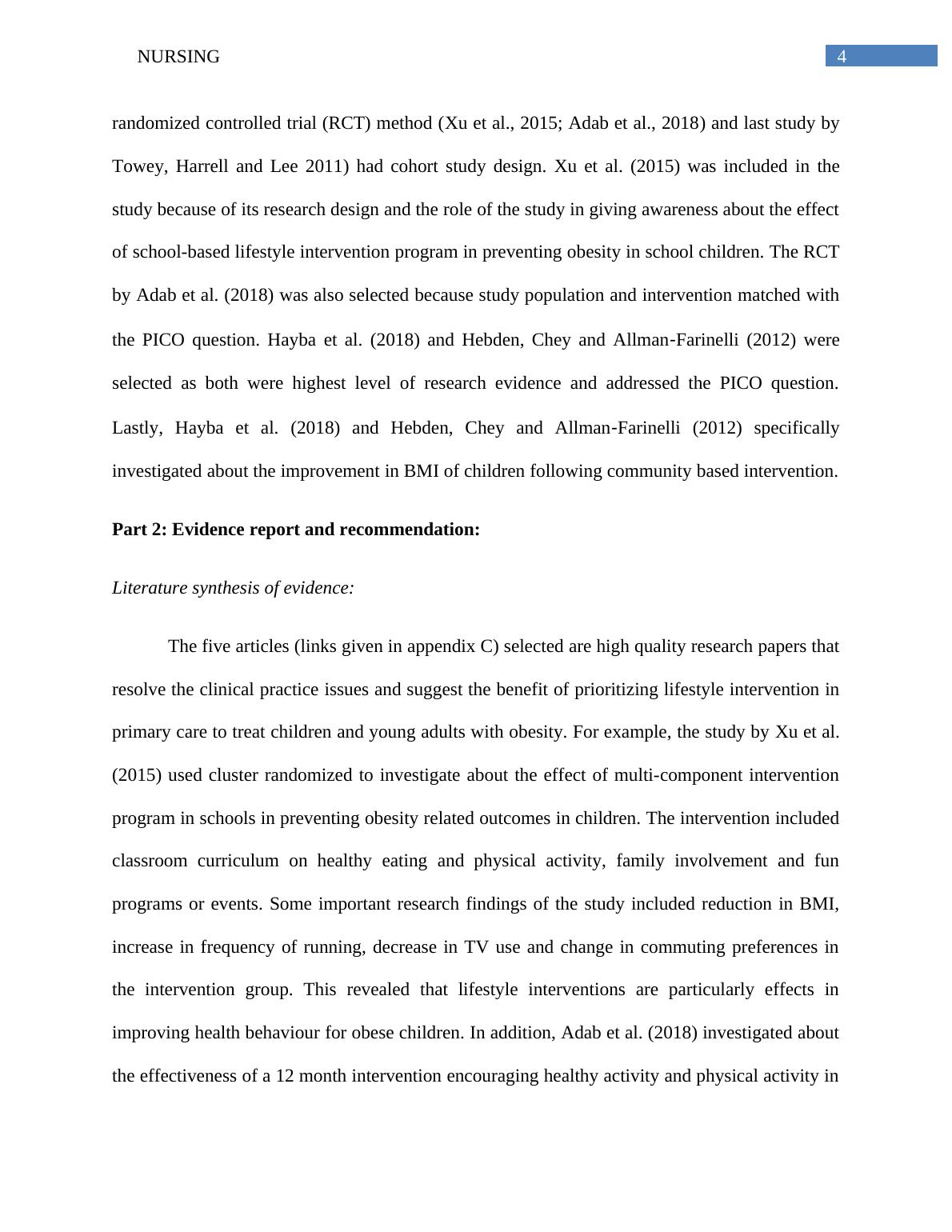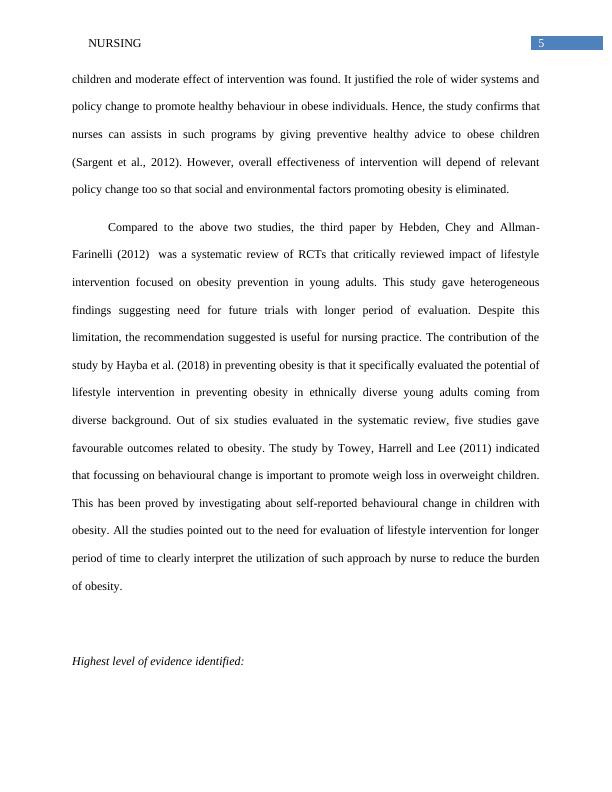Effectiveness of Lifestyle Intervention in Preventing Obesity in Children and Young Adults
Added on 2022-11-18
22 Pages3771 Words75 Views
Running head: NURSING
Nursing
Name of the student:
Name of the University:
Author’s note
Nursing
Name of the student:
Name of the University:
Author’s note

1NURSING
PART 1: Evidence Search
Clinical issue:
The main problem of focus for the study is the high incidence of obesity in children.
According to Australian Institute of Health and Welfare (AIHW) 2017), the one-quarter of
children and adolescents are overweight in Australia. In the year 2014-2015., 27% of children
and adolescents between the age of 5-17 years were obese or overweight. These statistics are
alarming because obesity contributes to total health burden, adverse health outcomes and
economic impacts due to the high risk of developing other chronic disease too. Hence, unless
adequate steps are taken to prevent obesity, childhood obesity can lead to development of other
physical illness such as cardiovascular disease, type 2 diabetes, renal complication, fatty liver
disease, asthma and infertility (Lobstein et al., 2015).
Context of the clinical practice:
During my practice as a registered nurse, I came across many obese children and young
adults who were facing health issues because of obesity. The BMI of these children was higher
than normal and many were dependent on pharmacological treatment for weight loss. However, I
always had the dilemma whether pharmacological intervention is better for them or lifestyle
intervention should be prioritized to prevent obesity. My personal opinion was that obesity
reduction should start with lifestyle intervention as it eliminates the key risk factors leading to
obesity. However, I was clueless regarding the effectiveness of such intervention for obese
children and young adults.
PART 1: Evidence Search
Clinical issue:
The main problem of focus for the study is the high incidence of obesity in children.
According to Australian Institute of Health and Welfare (AIHW) 2017), the one-quarter of
children and adolescents are overweight in Australia. In the year 2014-2015., 27% of children
and adolescents between the age of 5-17 years were obese or overweight. These statistics are
alarming because obesity contributes to total health burden, adverse health outcomes and
economic impacts due to the high risk of developing other chronic disease too. Hence, unless
adequate steps are taken to prevent obesity, childhood obesity can lead to development of other
physical illness such as cardiovascular disease, type 2 diabetes, renal complication, fatty liver
disease, asthma and infertility (Lobstein et al., 2015).
Context of the clinical practice:
During my practice as a registered nurse, I came across many obese children and young
adults who were facing health issues because of obesity. The BMI of these children was higher
than normal and many were dependent on pharmacological treatment for weight loss. However, I
always had the dilemma whether pharmacological intervention is better for them or lifestyle
intervention should be prioritized to prevent obesity. My personal opinion was that obesity
reduction should start with lifestyle intervention as it eliminates the key risk factors leading to
obesity. However, I was clueless regarding the effectiveness of such intervention for obese
children and young adults.

2NURSING
Clinical question:
The main health topic for this research is the effectiveness of lifestyle intervention in
preventing obesity in children and young adults. The domain of the question in therapy as it is
focussed on specific intervention for effective outcomes in obese children and adults. The PICO
question that will guide the search process are as follows:
In children and young adults with obesity (P), what is the effectiveness of lifestyle intervention
(I) compared to usual care (C) in preventing obesity (O)?
From the above PICO question, the population of interest, key area of focus and relevant
outcomes to look for in study is clear. PICO is an appropriate framework for developing a
searchable question (Raich & Skelly, 2013).
Rationale for research:
Obese children are most like to be obese during adulthood too and suffer from chronic
diseases at younger age compared to other children (AIHW, 2017). Hence, to reduce later life
complications for children with obesity, taking evidence based approach to identify the potential
of lifestyle intervention in preventing obesity and reducing health risk is important. The main
rationale for using evidence based approach to interrogate about the clinical practice issue is that
this process helps to evaluate research papers based on their strength and weakness and make
conclusion regarding the effectiveness of a specific intervention for patient (Stevens, 2013).
Evidence search:
To identify best research evidence to address the above PICO question, the search for
literature was done from university library database. The search terms of keywords were taken
Clinical question:
The main health topic for this research is the effectiveness of lifestyle intervention in
preventing obesity in children and young adults. The domain of the question in therapy as it is
focussed on specific intervention for effective outcomes in obese children and adults. The PICO
question that will guide the search process are as follows:
In children and young adults with obesity (P), what is the effectiveness of lifestyle intervention
(I) compared to usual care (C) in preventing obesity (O)?
From the above PICO question, the population of interest, key area of focus and relevant
outcomes to look for in study is clear. PICO is an appropriate framework for developing a
searchable question (Raich & Skelly, 2013).
Rationale for research:
Obese children are most like to be obese during adulthood too and suffer from chronic
diseases at younger age compared to other children (AIHW, 2017). Hence, to reduce later life
complications for children with obesity, taking evidence based approach to identify the potential
of lifestyle intervention in preventing obesity and reducing health risk is important. The main
rationale for using evidence based approach to interrogate about the clinical practice issue is that
this process helps to evaluate research papers based on their strength and weakness and make
conclusion regarding the effectiveness of a specific intervention for patient (Stevens, 2013).
Evidence search:
To identify best research evidence to address the above PICO question, the search for
literature was done from university library database. The search terms of keywords were taken

3NURSING
from the PICO question. Some important keywords that was used to search and retrieve relevant
articles included ‘lifestyle intervention’, ‘obesity’, ‘overweight’, ‘children’, ‘young adults’,
‘obesity prevention’, ‘obesity reduction’ and ‘weight loss’. The search process was further
refined by using different search phrases such as ‘Lifestyle intervention for obese adults’ and
‘Effectiveness of lifestyle intervention in preventing obesity’. The details of the search history
have been attached in appendix A. To further narrow the search process and ensure that most
relevant papers are included for review, the following inclusion criteria was used:
All research articles should be published within 2010 to 2019
Research papers must have lifestyle intervention as the main focus of the study
It should report on outcomes related to obesity prevention or weight loss
Only those papers should be taken which have children or young adults (till 35 years of
age) as research participants
Both qualitative and quantitative types of study can be included to find diverse idea
regarding benefit of lifestyle intervention
Preference should be given to research design that comes under top level according to
the JBI hierarchy of evidence such as systematic reviews and randomized controlled trial
(RCT)
Only reviewed journal articles published in databases to be included
Articles selected and the rationale for choosing the articles:
Five articles were found relevant to answer the research question and a detailed summary
of each article is provided in appendix B. Out of five articles, two studies by Hayba et al. (2018)
and Hebden, Chey and Allman‐Farinelli (2012) had systematic review, other two used
from the PICO question. Some important keywords that was used to search and retrieve relevant
articles included ‘lifestyle intervention’, ‘obesity’, ‘overweight’, ‘children’, ‘young adults’,
‘obesity prevention’, ‘obesity reduction’ and ‘weight loss’. The search process was further
refined by using different search phrases such as ‘Lifestyle intervention for obese adults’ and
‘Effectiveness of lifestyle intervention in preventing obesity’. The details of the search history
have been attached in appendix A. To further narrow the search process and ensure that most
relevant papers are included for review, the following inclusion criteria was used:
All research articles should be published within 2010 to 2019
Research papers must have lifestyle intervention as the main focus of the study
It should report on outcomes related to obesity prevention or weight loss
Only those papers should be taken which have children or young adults (till 35 years of
age) as research participants
Both qualitative and quantitative types of study can be included to find diverse idea
regarding benefit of lifestyle intervention
Preference should be given to research design that comes under top level according to
the JBI hierarchy of evidence such as systematic reviews and randomized controlled trial
(RCT)
Only reviewed journal articles published in databases to be included
Articles selected and the rationale for choosing the articles:
Five articles were found relevant to answer the research question and a detailed summary
of each article is provided in appendix B. Out of five articles, two studies by Hayba et al. (2018)
and Hebden, Chey and Allman‐Farinelli (2012) had systematic review, other two used

4NURSING
randomized controlled trial (RCT) method (Xu et al., 2015; Adab et al., 2018) and last study by
Towey, Harrell and Lee 2011) had cohort study design. Xu et al. (2015) was included in the
study because of its research design and the role of the study in giving awareness about the effect
of school-based lifestyle intervention program in preventing obesity in school children. The RCT
by Adab et al. (2018) was also selected because study population and intervention matched with
the PICO question. Hayba et al. (2018) and Hebden, Chey and Allman‐Farinelli (2012) were
selected as both were highest level of research evidence and addressed the PICO question.
Lastly, Hayba et al. (2018) and Hebden, Chey and Allman‐Farinelli (2012) specifically
investigated about the improvement in BMI of children following community based intervention.
Part 2: Evidence report and recommendation:
Literature synthesis of evidence:
The five articles (links given in appendix C) selected are high quality research papers that
resolve the clinical practice issues and suggest the benefit of prioritizing lifestyle intervention in
primary care to treat children and young adults with obesity. For example, the study by Xu et al.
(2015) used cluster randomized to investigate about the effect of multi-component intervention
program in schools in preventing obesity related outcomes in children. The intervention included
classroom curriculum on healthy eating and physical activity, family involvement and fun
programs or events. Some important research findings of the study included reduction in BMI,
increase in frequency of running, decrease in TV use and change in commuting preferences in
the intervention group. This revealed that lifestyle interventions are particularly effects in
improving health behaviour for obese children. In addition, Adab et al. (2018) investigated about
the effectiveness of a 12 month intervention encouraging healthy activity and physical activity in
randomized controlled trial (RCT) method (Xu et al., 2015; Adab et al., 2018) and last study by
Towey, Harrell and Lee 2011) had cohort study design. Xu et al. (2015) was included in the
study because of its research design and the role of the study in giving awareness about the effect
of school-based lifestyle intervention program in preventing obesity in school children. The RCT
by Adab et al. (2018) was also selected because study population and intervention matched with
the PICO question. Hayba et al. (2018) and Hebden, Chey and Allman‐Farinelli (2012) were
selected as both were highest level of research evidence and addressed the PICO question.
Lastly, Hayba et al. (2018) and Hebden, Chey and Allman‐Farinelli (2012) specifically
investigated about the improvement in BMI of children following community based intervention.
Part 2: Evidence report and recommendation:
Literature synthesis of evidence:
The five articles (links given in appendix C) selected are high quality research papers that
resolve the clinical practice issues and suggest the benefit of prioritizing lifestyle intervention in
primary care to treat children and young adults with obesity. For example, the study by Xu et al.
(2015) used cluster randomized to investigate about the effect of multi-component intervention
program in schools in preventing obesity related outcomes in children. The intervention included
classroom curriculum on healthy eating and physical activity, family involvement and fun
programs or events. Some important research findings of the study included reduction in BMI,
increase in frequency of running, decrease in TV use and change in commuting preferences in
the intervention group. This revealed that lifestyle interventions are particularly effects in
improving health behaviour for obese children. In addition, Adab et al. (2018) investigated about
the effectiveness of a 12 month intervention encouraging healthy activity and physical activity in

5NURSING
children and moderate effect of intervention was found. It justified the role of wider systems and
policy change to promote healthy behaviour in obese individuals. Hence, the study confirms that
nurses can assists in such programs by giving preventive healthy advice to obese children
(Sargent et al., 2012). However, overall effectiveness of intervention will depend of relevant
policy change too so that social and environmental factors promoting obesity is eliminated.
Compared to the above two studies, the third paper by Hebden, Chey and Allman‐
Farinelli (2012) was a systematic review of RCTs that critically reviewed impact of lifestyle
intervention focused on obesity prevention in young adults. This study gave heterogeneous
findings suggesting need for future trials with longer period of evaluation. Despite this
limitation, the recommendation suggested is useful for nursing practice. The contribution of the
study by Hayba et al. (2018) in preventing obesity is that it specifically evaluated the potential of
lifestyle intervention in preventing obesity in ethnically diverse young adults coming from
diverse background. Out of six studies evaluated in the systematic review, five studies gave
favourable outcomes related to obesity. The study by Towey, Harrell and Lee (2011) indicated
that focussing on behavioural change is important to promote weigh loss in overweight children.
This has been proved by investigating about self-reported behavioural change in children with
obesity. All the studies pointed out to the need for evaluation of lifestyle intervention for longer
period of time to clearly interpret the utilization of such approach by nurse to reduce the burden
of obesity.
Highest level of evidence identified:
children and moderate effect of intervention was found. It justified the role of wider systems and
policy change to promote healthy behaviour in obese individuals. Hence, the study confirms that
nurses can assists in such programs by giving preventive healthy advice to obese children
(Sargent et al., 2012). However, overall effectiveness of intervention will depend of relevant
policy change too so that social and environmental factors promoting obesity is eliminated.
Compared to the above two studies, the third paper by Hebden, Chey and Allman‐
Farinelli (2012) was a systematic review of RCTs that critically reviewed impact of lifestyle
intervention focused on obesity prevention in young adults. This study gave heterogeneous
findings suggesting need for future trials with longer period of evaluation. Despite this
limitation, the recommendation suggested is useful for nursing practice. The contribution of the
study by Hayba et al. (2018) in preventing obesity is that it specifically evaluated the potential of
lifestyle intervention in preventing obesity in ethnically diverse young adults coming from
diverse background. Out of six studies evaluated in the systematic review, five studies gave
favourable outcomes related to obesity. The study by Towey, Harrell and Lee (2011) indicated
that focussing on behavioural change is important to promote weigh loss in overweight children.
This has been proved by investigating about self-reported behavioural change in children with
obesity. All the studies pointed out to the need for evaluation of lifestyle intervention for longer
period of time to clearly interpret the utilization of such approach by nurse to reduce the burden
of obesity.
Highest level of evidence identified:

End of preview
Want to access all the pages? Upload your documents or become a member.
Related Documents
Roles of Healthcare Workers in Managing Obesity/Overweight Among Young Generationlg...
|1
|1583
|319
Assessment 1 Critical Appraisal Literature Reviewlg...
|7
|1971
|390
Research problem and systematic search strategy for NURS6O30 Research and Evidencelg...
|10
|3682
|381
Physical inactivity as a risk factor of chronic disease burden in Australialg...
|9
|2224
|136
Societal Infant Problems: Childhood Obesitylg...
|20
|4013
|79
Using PICO Framework to Formulate Clinical Questions for Evidence-Based Nursing Research on Paleo Diet and Weight Losslg...
|28
|1798
|457
